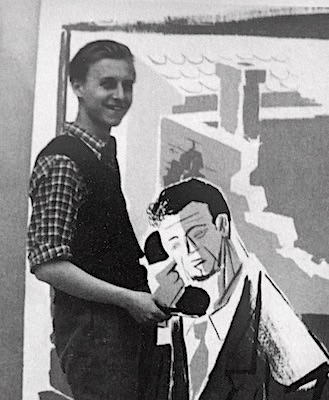Darvas Árpád
1927 - 2015

Arpad Darvas
Arpad Darvas was one of the most important poster artists in the generation that started in the 1950's. Darvas was a pioneer who renewed poster art with his new techniques and styles. He was one of the first artists to introduce pop art to Hungary. Darvas’ works betray a unique and archetypal quality.
Between 1944 and 1946, Darvas attended to the University of Applied Arts and, after its reorganization, he spent the years 1947 to 1951 at the University of Fine Arts. Darvas’s beloved master was György Konecsni, and among his classmates were Ernyei, Máté, Zelenák and Zala.
From the beginning of the 1950's until 1994, Darvas worked for MOKÉP (Hungarian state film dealer company), which ensured that film posters would play an important role in his oeuvre. Between 1963 and 1983 Darvas was member of the Papp-group and took part in their exhibitions. Darvas was working in all the fields of applied graphics, designing menus, images for companies, designs of fairs and exhibitions, flyers, etc. He also worked in autonomic graphic art and painting as well. Since 2004, Darvas has been a member of the Hungarian Poster Association (MPT).
In his first period, Darvas used the painting-like and expressive new poster style that followed the socialist realist style. In his early works, the marks of the paintbrush and expressive details, such as Picasso-like drawings, are remarkable. His film posters of the 1950s, which display strong colors and on which light-dark contrasts dominate, evoke the world of film noir. Darvas is strongly attracted to vivid and distinctive colors; he also enjoys placing complementary colors side by side. Contemporary painting and popular visual culture are Darvas’ primary artistic influences.
Darvas was one of the first artists in Hungary to use photomontage on the poster. This technique became popular later in the 1960's. Another technique, paper-cutting, which also became popular in the 1960's, appeared in Darvas’ works in the late 1950s. His compositions are extremely dynamic thanks to his use of fine bright colors and their strong contrasts. Darvas harnesses the power of the contrasts in designing photomontage, which invariably produces a new meaning. He even employs this effect when he forgoes the use of photos. Darvas created some of his designs with colorful brush paint and paper cuts, which is occasionally combined with details of photos. Some of his compositions remind us of Rauschenberg’s pictures.
Darvas created absolutely outstanding designs for films like the 1961 Italian count of Monte Cristo. He designed a great poster for Fellini’s “8 and ½” which was never printed, although Lajos Görög’s design, which was chosen instead, is also fantastic. His designs always reflect the world of the advertised movie.
In the second half of the 1960s, he was one of the first artists to apply American pop art painting to poster art. While pop art appeared in the United States as a critical response to consumerism, in Hungary it symbolized the desired “Western” world. His artistic tools fit perfectly to the poster genre: its vivid, extreme colors were remarkable, especially combined with fresh, beautiful shapes. Darvas added to this style very decorative hand-drawn letters. He introduced the visual world of comics to poster art. Indeed, his posters resemble Roy Lichtenstein’s art, as he shows the raster dots on the surface and his characters are also typical comic-types shown in the middle of an action. This visual world fitted perfectly with movie posters, especially American films. Besides the influence of comic art, the psychedelic American posters of the 1960s also made an impression on Darvas, leading him to create several colorful, decorative posters with beautiful drawn letters.
In the 1970s, this colorful pop art period was replaced by a surrealist poster style comprised of pencil drawings and few colors. At the beginning of the 1980s, Darvas turned to painting and made a series of film posters using an oil painting technique. The surrealist sensibility remains, however, and he continues to mingle highly unconventional details (like men with animal heads, etc.). His Western movie posters exhibit a strong picturesque tendency. .





































































